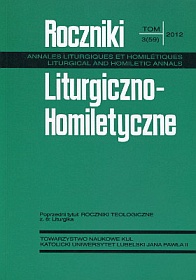Connection of the Theological Formulas of “Creed” and the Euchology of the Roman Missal 2002
Abstract
We have tried to show in our research the connection formulas of faith in God and the Church in relation to the Mass euchology the sense in which the profession of faith in God (Credo in unum Deum) is, and what is not identical to an article of faith in the Church (et... Ecclesiam). The similarity of these articles of faith has analogous nature, but it is not identical, because where there are similarities, the differences are even bigger, particularly in relation to God. The belief that the Church is holy and universal (catholic), that is one and apostolic, is inseparable from faith into the Triune God. But when, in the Apostles’ Creed we profess faith in the Church (et... Ecclesiam), then we use here a different form than in the article regarding belief in God (Credo in... Deum), because God is the Creator, and the Church is His creation, because the goodness of God is the source of all the gifts which the Church enjoys. The difference in the meaning of the creed in unum Deum, and et... Ecclesiam resolved so clearly the Catechism of the Catholic Church (cf. 750). This is confirmed by the Pope Benedict XVI, and even those of the theologians who wrote before its release in 1992.
Even meta-historicity and theandric reality of the Church in terms of Paul Evdokimov did not storm the structure of the economy of salvation, which was created and revealed to us by God in Jesus Christ and the Church after Pentecost. It provided us in the Church and through the Church (and its liturgy). According to Evdokimov, the mystery of the Church still comes from the creative act of God, and it remains creation.
The decisions of the ancient doctrine of the Church and later on over the centuries, remain no doubt that the Apostolic Church is that only through the saving work of Christ the Lord, and their credibility derives from its permanent presence in the Church.
However, on the other hand, we know that He identifies himself with the Church (with his brothers, with their followers), as it is seen in a very explicit way in the testimony of Acts, the risen Jesus in dialogue with Saul (cf. Acts 9:4), which has immediately understood that by persecuting the disciples (the Church), haunted by the one who blinded him with its splendor on the road to Damascus. Then, the converted Saul–Paul, develops profound doctrine of the Church as the Mystical Body of Christ. But never in a physical manner. He does not identify the Church and Christ. This can be noted especially in his letters to the local communities. For example a sinful Church in Corinth (1 Cor 5), which Paul had to rebuke. Besides, a very eloquent text, talking about rectifying the identified shortcomings sufferings of Christ (Col 1:24). We can clearly see that it is a body which is the Church, its good that is done by the suffering endured in the flesh by Paul himself for the name of Jesus. So neither Paul nor the Church is presented as a perfect one.
A similar picture of the Church emerges from Missal’s euchology, which we discussed on selected examples of the collects and prefaces, which in turn confirm and demonstrate the true meaning of the Credo in unum Deum, and et... Ecclesiam. Both the differences and similarities within the meaning of these syntagmata don’t remain any doubt that the interpretation of these articles of faith in the Catechism of the Catholic Church is consistent with that what emerges from the typical edition of the latest Roman Missal. Our conclusions are based not only on the Magisterium of the Church, but also in its praxis, which has always had a profession of faith (lex credendi) and accounted for the liturgical space of the expression (lex orandi). We have to say that nowhere in the texts of the Mass euchology such a use occurs a syntagma et... Ecclesiam (in acc.), which would suggest that we believe in the Church in the same sense as in unum Deum. The theological content of the prayers clearly shows an understanding of this syntagma of the Church, which was articulated by the Catechism (CCC 750) and the Magisterium of the Church, along with those who comment on them.
In this article, we wanted to show the validity and verifiability of such an understanding and positions that avoid ambiguity and even confusion in the interpretation of the meaning of these two interdependent articles of faith, a subject to the differences in their interpretation.
We can say that we discussed euchology that is the thumbnail of the Roman Missal according to ecclesiology and thus portrayed a vision of the Church over the centuries in the key of prayer, centered in the lens just like the one liturgical book, which is a Missal.
References
Dizionario di Teologia Fondamentale. R. Latourelle, R. Fisichella (dir. da). A a cura di R. Fisichella. Assisi: Cittadella Editrice 1990.
Evdokimov P.: Prawosławie. Przeł. J. Klinger. Warszawa: IW PAX 2003.
Miazek J.: Misterium Wielkiego Postu w modlitwach mszalnych dawnej i współczesnej liturgii rzymskiej. Studium liturgiczno-teologiczne. Warszawa 1997.
Nadolski B. (oprac.): Leksykon liturgii. Poznań: Pallottinum 2006.
Ratzinger J.: Wprowadzenie w chrześcijaństwo. Tł. Z. Włodkowa. Kraków: Wyd. Znak 2006.
Ratzinger J.: Chrystus i Jego Kościół. Przeł. W. Szymona OP. Kraków: Wyd. eSPe 20052. [Tyt. oryg. Il cammino pasquale. Milano: Àncora Editrice].
Sullivan F.A.: The Church We Believe In: One, Holy, Catholic and Apostolic. New York 1988.

